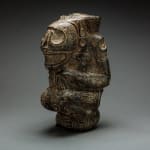Taíno Zemí Sculpture, AD 1000 - AD 1500
Stone
37.8 x 25.4 cm
14 7/8 x 10 in
14 7/8 x 10 in
LO.1323
Further images
This extraordinary sculpture depicts a zemi figure- the physical manifestation of a Taino god, spirit or ancestor. Carved from a dark, dense stone, the figure assumes a ritual crouching position,...
This extraordinary sculpture depicts a zemi figure- the physical manifestation of a Taino god, spirit or ancestor. Carved from a dark, dense stone, the figure assumes a ritual crouching position, with his legs bent underneath him at the knees. The hands rest just below the chin with the fingers pointing vertically downwards. Unusually the depth of the sculpture is much longer than the width; this is accentuated by the face which projects forward. The eye-sockets and the wide grimacing mouth dominate the face and suggest a skeletal form. The appearance of the nose, particularly the nostrils, as well as the positioning of the hands suggest that human and zoomorphic features may have been merged together. The Taino were polytheistic and believed in the existence of an afterlife- in which the souls of the dead would return in the shape of animals. In Taino mythology animals were also regarded as ancestors so it is not inconceivable that this dual identity should be encapsulated in an important piece of ritual sculpture.
Another fascinating aspect of this work is the flat circular platform just behind the figure’s head. Viewed in profile, it appears to represent some kind of basket or ritual object carried on the zemi’s back. Elaborate geometric motifs, principally coils and triangular incisions, adorn this as well as the pedestal and headdress of the figure. These patterns may reflect tattoos or textile designs worn by members of the Taino elite. Although the precise function of such a carving is unknown, many Taino stone sculptures had some association with the use of cohoba. This was a hallucinogenic powder ground from trees native to the region. It was used by shamans to induce a trance-like state of mind in which they would be able to communicate with the souls of the dead. The small circular platform on this piece may have been used as a grinding surface or to support other implements associated with this ritual. A sculpture of this size and complexity would undoubtedly have been the preserve of the chieftain (cacique) or his closest retinue and offers us a rare glimpse into the spiritual world of the Taino. (AM)
Another fascinating aspect of this work is the flat circular platform just behind the figure’s head. Viewed in profile, it appears to represent some kind of basket or ritual object carried on the zemi’s back. Elaborate geometric motifs, principally coils and triangular incisions, adorn this as well as the pedestal and headdress of the figure. These patterns may reflect tattoos or textile designs worn by members of the Taino elite. Although the precise function of such a carving is unknown, many Taino stone sculptures had some association with the use of cohoba. This was a hallucinogenic powder ground from trees native to the region. It was used by shamans to induce a trance-like state of mind in which they would be able to communicate with the souls of the dead. The small circular platform on this piece may have been used as a grinding surface or to support other implements associated with this ritual. A sculpture of this size and complexity would undoubtedly have been the preserve of the chieftain (cacique) or his closest retinue and offers us a rare glimpse into the spiritual world of the Taino. (AM)











